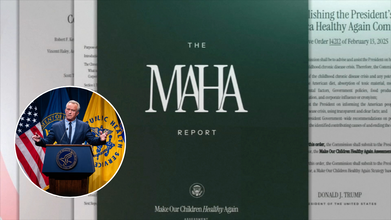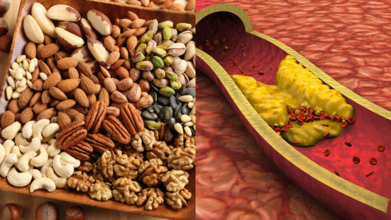- Health Conditions A-Z
- Health & Wellness
- Nutrition
- Fitness
- Health News
- Ayurveda
- Videos
- Medicine A-Z
- Parenting
- Web Stories
What Is Pulmonary Fibrosis and Why That Annoying Cough Might Be More Than Just a Cold

Credits: Canva
If you’ve been coughing for weeks, blaming it on “lingering winter sniffles” or chalking it up to “just getting older,” it might be time to step away from the cough syrup and lean in for some uncomfortable truth. Your cough could be more than a seasonal annoyance. In rare but serious cases, it could be a red flag for a life-limiting condition called pulmonary fibrosis.
What is Pulmonary Fibrosis?
In plain terms, “pulmonary” means lungs, and “fibrosis” means scarring. It’s a serious, progressive condition where lung tissue becomes scarred and stiff, making it increasingly hard to breathe.
Reportedly, there’s currently no cure. Treatments exist, but they mainly slow down the damage rather than reverse it. The sooner you get diagnosed, the better your chances of managing symptoms and that’s where spotting the signs early is crucial.
Symptoms to Watch For
- Shortness of breath (especially when climbing stairs or speed-walking to catch the bus)
Why That Cough Happens
Coughing is your body’s bouncer, booting out anything that might harm your lungs — dust, smoke, rogue crumbs, the works. The process involves your vocal cords clamping shut, then snapping open with a burst of air.
With pulmonary fibrosis, this reflex can get stuck on a loop. Coughing irritates the vocal cords, which makes you cough more, which irritates them further, a vicious cycle that can turn even a quiet cup of tea into a coughing fit.
The Four Flavours of Cough
- Acute cough – Lasts less than three weeks; often tied to infections or irritants.
Coughs can also be:
- Dry/unproductive – Triggered by things like temperature changes, dusty air, or laughing.
Who’s More at Risk?
While pulmonary fibrosis can happen to anyone, your risk might be higher if you:
- Are over 50
Managing the Cough
A pulmonary fibrosis cough often doesn’t respond to standard cough medicines. Instead, treatment usually focuses on easing symptoms and improving quality of life.
Your doc may recommend alternative medications used for chronic cough in other conditions. These don’t cure the scarring but can make the coughing less intrusive. They’ll also want to check for other contributing factors like acid reflux, sinus issues, or side effects from medication, because if those are making things worse, tackling them can help.
Everyday Coping Tricks
While you work with your doctor, you can try a few lifestyle tweaks to manage coughing fits:
- Avoid smoky, dusty, or heavily polluted spaces
Pulmonary fibrosis is rare, but catching it early can mean more treatment options and better management. Plus, you’ll finally know whether your cough is from a stubborn cold or something that needs closer attention. Your cough could be a harmless side effect of a dusty ceiling fan or it could be your body waving a red flag.
Too Many Pills, Too Little Produce: Draft 'Make America Healthy Again' Report Blames Junk Food, Pills And Inactivity

Credits: Health and me
The US Department of Health and Human Services (HHS), under Secretary Robert F. Kennedy Jr., has been touting its “Make America Healthy Again” (MAHA) initiative as a turning point in public health. Framed as one of Kennedy’s signature achievements, the report promised bold action to address America’s chronic health crises: obesity, diabetes, heart disease, and the overprescription of pharmaceuticals.
A draft version obtained by reporters tells a different story. Instead of sweeping reforms to food, farming, or pharmaceutical regulation, the MAHA report leans heavily on additional research studies, awareness campaigns, and incremental policy suggestions. For a coalition that expected Kennedy to challenge entrenched interests—from pesticide manufacturers to Big Food—the document feels less like a revolution and more like a compromise.
What Are The Four Problem Areas?
The draft report identifies four main drivers of chronic disease in the United States:
- Poor diets dominated by ultraprocessed foods, sugars, and additives.
- Chemical exposure from pesticides and environmental pollutants.
- Lack of physical activity, worsened by sedentary jobs and urban lifestyles.
- Overuse of prescription medications, particularly among children and older adults.
These themes mirror Kennedy’s longstanding critiques of America’s health system. Yet, the policies outlined in the draft stop short of mandating aggressive reform. Instead, they recommend more studies, more definitions, and more “public awareness” campaigns.
Where the Bold Promises Fall Short In MAHA Report?
Kennedy built his reputation criticizing chemicals like glyphosate, high-fructose corn syrup, and ultraprocessed snacks that dominate the American diet. Farmers and food manufacturers braced for the MAHA report to recommend bans or new regulations. Instead, the draft calls for a public “confidence-building” campaign to reassure Americans about pesticides.
This pivot has disappointed many in Kennedy’s own coalition. Public health experts like Marion Nestle, professor emerita of nutrition at NYU, argue the draft contradicts the urgency of America’s chronic disease crisis. “The first report promised bold policies to protect children’s health. No such luck here,” she told reporters.
Industry Relief, Activist Frustration
For the agricultural sector, the draft report is a relief. It proposes partnerships with major farm companies and research into “precision technology” to help reduce pesticide use—steps that industry leaders see as constructive rather than combative.
But health advocates feel sidelined. Kari Hamerschlag, deputy director of food and agriculture at Friends of the Earth, warned that without funding, the report’s recommendations won’t translate into healthier outcomes. “This is not going to transform our food and farming system. They need to put resources behind their recommendations,” she said.
Processed Foods and the Unfinished Fight
Perhaps the biggest surprise in the draft is its limited attention to ultraprocessed foods. The MAHA movement originally spotlighted processed snacks and additives as central culprits in the nation’s obesity epidemic. But the draft only mentions that government agencies will “define” ultraprocessed foods and continue education campaigns.
Former FDA Commissioner Dr. David Kessler has argued that ingredients like refined sugars and flours should be declared unsafe. Yet the draft sidesteps any such regulatory proposals, leaving critics frustrated. Dr. Jim Krieger of Healthy Food America noted: “What about removing them from schools? Restricting marketing? Labeling packages? None of that is here.”
Research Without Teeth
The draft MAHA document devotes significant space to research priorities. It calls for the National Institutes of Health (already facing severe budget cuts under the Trump administration) to study vaccine injury, autism, infertility, prescription drug use, and nutrition. It also proposes AI-driven tools to accelerate research on pediatric cancers.
While these initiatives sound ambitious, they are contingent on funding that may never materialize. Without resources, they risk becoming yet another set of unfulfilled promises.
The Political Undercurrent
The White House has been cautious about the report’s release. A spokesperson called the draft “speculative literature” until officially endorsed. But insiders suggest the policies align closely with what was already previewed to the administration.
That alignment may explain the softened language around pesticides and ultraprocessed foods. For an administration prioritizing farmer support and deregulation, MAHA’s original vision of challenging chemical companies and processed food giants was politically untenable.
Is The New MAHA Report Building Bridges or Losing Focus?
Calley Means, one of Kennedy’s advisers, urged supporters to “build bridges” with farmers and agribusiness rather than treat them as enemies. It’s a pragmatic strategy, but critics argue it dilutes the urgency of tackling the systemic causes of poor health.
David Murphy, a former Kennedy finance director and now founder of United We Eat, framed the debate succinctly: “No one’s trying to take away farmers’ rights to grow food. We’re asking companies whose products cause harm to be held liable.” That principle, however, is largely absent from the draft.
What This Means for The People of America?
For everyday Americans grappling with obesity, diabetes, or high medical bills, the draft report offers little immediate relief. It encourages healthier diets, more exercise, and reduced reliance on medications—but without meaningful changes to food policy, medical regulation, or funding streams, these remain aspirational goals.
In essence, the report acknowledges the crises but avoids decisive confrontation with the industries fueling them. The result is a strategy that risks being too cautious to make a measurable impact.
The MAHA Commission’s final report is expected soon, but public health advocates are already voicing skepticism. Hundreds have signed letters urging the administration to address chemical exposures and ultraprocessed foods more directly. Whether those appeals shape the final draft remains to be seen.
What’s clear is that America’s chronic health problems—rising obesity, diabetes, cancer, and mental health conditions—demand more than “awareness campaigns.” Without stronger action, the “Make America Healthy Again” slogan risks becoming another empty political catchphrase.
A 4-Step Science-Backed Routine That Works for Every Skin Type

There was a time when skincare felt like a competitive sport. People layered acids, scrubbed their faces raw, and measured success in stings, peels, and redness. But times are changing. A new, science-backed wave is sweeping in, one that values results without leaving your skin feeling like it has been through a survival reality show.
From Shelf Overload to Skincare Simplicity
For years, we’ve been told more is better. More products, more steps, more actives, until our bathroom shelves looked like mini-pharmacies. But skin, much like us, thrives in balance. Aggressive routines may deliver quick wins, but they often come with side effects like irritation, dryness, or breakouts that weren’t invited to the party.The modern approach is a gentler, more measured one: using well-formulated products that are kind to the skin barrier but still pack enough punch to make a visible difference. And the best part? You only need a few steps, not a 12-item shopping list.
The Four Steps That Actually Work
Malini Adapureddy, Founder of Deconstruct Skincare, swears by a routine that’s simple enough to remember before coffee and effective enough to see results in weeks. Designed for Indian skin and climate, this four-step method covers the essentials: cleansing, treating, moisturising, and protecting.
Step 1: The Clean Slate
Every story starts somewhere, and for your skin, that’s cleansing. But the goal isn’t to strip your face like it’s a frying pan that’s just seen a masala spill. A gentle oil-control face wash with salicylic acid and niacinamide is the ticket. Salicylic acid slips into pores to keep them clear, while niacinamide calms and balances.Step 2: The Targeted Glow Shot
Once the canvas is prepped, it’s time for the serum stage. Enter a 10% vitamin C serum with 0.5% ferulic acid. Vitamin C is your radiance best friend, helping to fade pigmentation and even out skin tone, while ferulic acid boosts its stability and antioxidant power. Together, they help defend against environmental stressors and bring your complexion back from the land of dull.Unlike some actives that feel like they’re burning through your soul, this combination is gentle enough for daily use.
Step 3: The Barrier Hug
Moisturiser is often seen as the “optional” step, especially if you have oily skin. But hydration isn’t just about adding water; it’s about locking it in. A lightweight, oil-free moisturiser with natural moisturising factors (NMF) and panthenol keeps your skin barrier happy. It helps reduce sensitivity, supports repair, and works in harmony with your actives. And in India’s hot, humid, sometimes dusty climate, that’s a much-needed shield.Step 4: The Non-Negotiable
Sunscreen. Always sunscreen. Whether you’re outside chasing errands or inside chasing deadlines, UV damage is sneaky. It causes pigmentation, speeds up ageing, and undoes all the hard work your serum and moisturiser put in. A broad-spectrum, gel-based sunscreen keeps things light, non-greasy, and comfortable, even under makeup.Why Gentle Works Better Than You Think
There’s a myth that 'strong' means 'effective'. In reality, harsh products can damage your skin barrier, leaving it inflamed and reactive. Gentle formulations, when done right, work gradually but deeply. They’re like the friend who doesn’t shout advice but still changes your life.Consistency is the secret here. When your skin isn’t constantly fighting irritation, it can focus on repairing itself, building resilience, and looking better over time.
Scientist Reveals the Tiny Foods That Can Transform Your Cholesterol in Just 10 Days

If you’ve ever stared at a packet of mixed nuts wondering whether to sprinkle them over your porridge or just eat them by the handful, here’s your permission slip: go for it. According to Dr Sarah Berry, a professor at King’s College London and Chief Scientist at ZOE, nuts and seeds are not just snackable; they are good for cholesterol crunching. In fact, swap some of your less healthy fats for these nutritional powerhouses, and you could lower your cholesterol by up to 10 per cent in just 10 days. That is faster than most fad diets.
The 10-Day Cholesterol Challenge
High cholesterol often feels like one of those invisible problems, until it suddenly is not. It can quietly build up in your arteries, increasing the risk of heart attacks and strokes. But Dr Berry, during an appearance on the Zoe podcast, said that you can make a real difference in under two weeks by tweaking, not overhauling, your diet. It’s not about eating less fat; it’s about eating the right kind of fat.
And this is where most people get it wrong. “Don’t do a low-fat diet,” Dr Berry warns, calling the idea “radical” to anyone still following decades-old advice. Instead, aim for a moderate-fat diet rich in polyunsaturated and monounsaturated fats—exactly the kinds you’ll find in nuts, seeds, and certain oils.
Why Low-Fat Diets Miss the Point
It is tempting to think cutting fat will cut cholesterol, but Dr Berry explains that’s a trap. Not all fats are bad. Saturated fats, found in red meat and some processed foods, can push LDL cholesterol—often dubbed “bad” cholesterol—into dangerous territory. But polyunsaturated fats, abundant in seeds, seed oils, and many nuts, do the opposite.
Simply adding nuts to your meals, whether as a snack, salad topping, or nut butter, can slash LDL cholesterol by 5 to 10 per cent. You have to make a swap. This benefit comes from replacing “harmful” fats, like those in certain animal products and fried foods, with healthier plant-based fats.
Seeds: The Cholesterol Fighters
Sunflower seeds, flaxseeds, chia seeds—they’re all loaded with polyunsaturated fatty acids that support heart health. Stir them into yoghurt, blend them into smoothies, or scatter them over roasted veggies. You’ll barely notice the extra effort, but your arteries will thank you.
Seed oils, like sunflower and flaxseed oil, can also be smart choices in moderation, adding healthy fats to your cooking without the cholesterol-raising impact of certain animal fats.
Rethinking Dairy, Meat, and Carbs
Dr Berry isn’t out to demonise all animal products. Fermented dairy like yoghurt and cheese gets a surprising green light. These foods, she says, don’t have the cholesterol-raising effect you might expect from their saturated fat content. That’s not permission to live on brie and cheddar, but it is a reason to stop fearing your cheese board.
Red meat, however, is a different story. Packed with saturated fats, it’s a direct contributor to rising cholesterol levels. Swapping steak nights for lentil stews or chickpea curries a couple of times a week could make a noticeable difference to your numbers.
Then there’s the carbohydrate conundrum. The real trouble lies with refined carbs like white bread, white rice, and sugary snacks. These are rapidly processed by your body and can be converted into triglycerides, which worsen cholesterol profiles. But whole grains are firmly in the “good for you” column. Wholegrain bread, brown rice, oats, and quinoa can help improve cholesterol levels when they replace the refined stuff.
Building Your 10-Day Cholesterol Menu
Swap your morning white toast for porridge topped with walnuts and chia seeds. Your mid-morning biscuit could become a small handful of almonds. At lunch, toss sunflower seeds into your salad, and use olive or sunflower oil for dressing. Dinner might feature grilled salmon or chickpeas instead of steak, with a side of quinoa instead of white rice.
Why This Works So Fast
Cholesterol levels can be surprisingly responsive to dietary changes. LDL cholesterol particles are constantly being produced and cleared from your bloodstream. When you replace saturated fats with healthier fats, you improve your body’s ability to remove LDL cholesterol. Combine that with reducing refined carbs and upping your wholegrain intake, and the improvement can be measurable in just days.
Dr Berry’s advice is refreshingly realistic: no calorie counting, no extreme restrictions, just sensible swaps. It’s about building habits you can maintain beyond the initial 10 days, keeping your cholesterol low for the long haul.
Forget the idea that lowering cholesterol means bland food and joyless salads. With nuts, seeds, and the right fats, you can eat deliciously and still give your heart a health boost in record time.
© 2024 Bennett, Coleman & Company Limited

